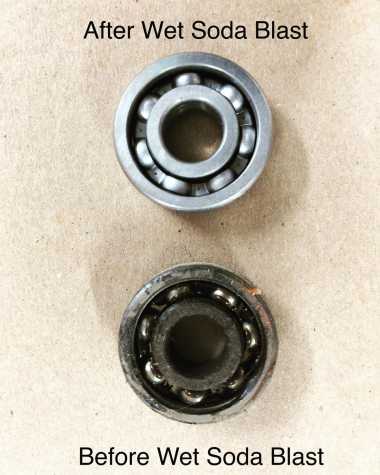When you’re working on a big renovation or refurbishing project, you may have large areas that you need to scour clean of peeling paint, grease, mold, smoke residue, or other unwanted substances.
Whether you’re working with a backyard shed, a room in your home, a car, or a piece of furniture, that amount of cleaning is too difficult to accomplish by hand. Instead, consider a process called soda blasting, which can do the job faster and better.
Check out these six common questions and answers about soda blasting to find out if it’s right for your project.
1. What is sandblasting vs. soda blasting?
You may have also heard the term “sandblasting” used with reference to the rigorous, high-pressure cleaning of a surface. Actually, “sandblasting” is an umbrella term covering all the different types of abrasive blasting.
A few of those types of blasting are:
☆ Walnut shell blasting
☆ Coconut shell blasting
☆ Glass bead blasting
☆ Soda blasting
Soda blasting refers to just one of many substances or materials that can be used to scour away paint or grime from tough surfaces.
2. Why is it called soda blasting?
Even though soda blasting fits in the same category as other types of abrasive blasting, the substance being used isn’t actually abrasive. It’s granulated sodium bicarbonate, which offers a far gentler treatment than using other granules like shells or beads. The sodium bicarbonate particles give this process its “soda” title.
3. Does soda blasting damage wood?

Before you begin soda blasting wood furniture, you’ll want to know if the process is going to damage the underlying wood or not. When it’s done correctly, soda blasting should not harm the wood surface you’re working on.
According to experts, the most important factor is the amount of pressure you use. Too much pressure and you might cause damage. Too little, and the process won’t be thorough or effective. Test your soda blasting equipment on an extra piece of wood first, to gauge how much pressure is required for the job.
4. What are some uses for soda blasting?
Soda blasting comes in handy for many different projects. People use it on chrome surfaces, plastic parts, or even certain types of glass (with caution, of course). Others swear by sandblasting wood to eliminate old paint, grime, and other caked-on debris.
 On softer metals like copper and aluminum, soda blasting can work wonders. It can even polish away light rust (although for heavy rust on hard metal, you may want to switch to sandblasting). Soda blasting smoothes the surface you’re treating, and it can even prevent rust from taking hold on the metal again.
On softer metals like copper and aluminum, soda blasting can work wonders. It can even polish away light rust (although for heavy rust on hard metal, you may want to switch to sandblasting). Soda blasting smoothes the surface you’re treating, and it can even prevent rust from taking hold on the metal again.
Soda blasting is also helpful if you have a room or object that has suffered damage from smoke or mold. The “soda” component (sodium bicarbonate) serves as a deodorizer. Blasting the surface with it can scour away more than just dirt; it may also eliminate or minimize odors from mildew, pet urine, mold, fire smoke, or cigarette smoke.
5. What are the benefits of soda blasting wood and other materials?
First of all, soda blasting has no negative impact on the environment. Any residue is completely biodegradable, non-toxic, and water-soluble. The whole process is earth-friendly, as well as effective.
Contrary to the roughness of sandblasting, soda blasting doesn’t leave pitted areas on metal surfaces. It does not generate heat and warp plastics. Instead, it offers a gentle, thorough cleaning that gradually scours away layers of paint or grease—slower than sandblasting, but much faster than industrial-strength hydro-blasting.
Where high-pressure streams of water can’t do the trick, and when sandblasting is too harsh a treatment, soda blasting is the ideal alternative.
6. What are the drawbacks of soda blasting?
There are a few significant drawbacks to soda blasting. First of all, it’s a little more expensive than sandblasting, so if you want a gentler process or a more earth-friendly option, you can expect to pay extra.
Soda blasting may take longer to get through tough layers of grease, grime, rust, or paint. Sandblasting is fast, powering through the unwanted material. So from that perspective, sandblasting has the advantage as a time-saver.
However, the setup required for a sandblasting job is far more complex than for a soda blasting job. Since the sandblasting process is so much harsher, users have to take extra care to protect and cover any objects or surfaces that they don’t want to be exposed to a high-pressure stream of sand.
If you’re taking the paint off an old building, for example, you’d need to cover plastic trim or windows before sandblasting heavily. With soda blasting, there’s much less prep work and protection involved.
Another minor disadvantage of soda blasting is the cleanup. After soda blasting wood furniture, a building, or some other object, you may notice a white, powdery film leftover on the surface. You’ll need to spray or wipe down the surface to get that residue off, which will take up a little more of your time.
Ultimately, soda blasting is an environmentally friendly and effective way to clean materials like wood, plastic, chrome, soft metals, or sturdy glass. After carefully researching techniques and pressure settings, try out the soda blasting process yourself and enjoy cleaner, smoother surfaces with very little manual labor.
- How to Get Rid of Wood Mites - September 24, 2020
- Can You Have Stained Doors With Painted Trim? - May 27, 2020
- Is Duct Tape Flammable? and Other Burning Questions About Duct Tape - April 2, 2020

Pat
Wednesday 2nd of February 2022
Would soda blasting cause the wood green when I stain it? Thanks Pat